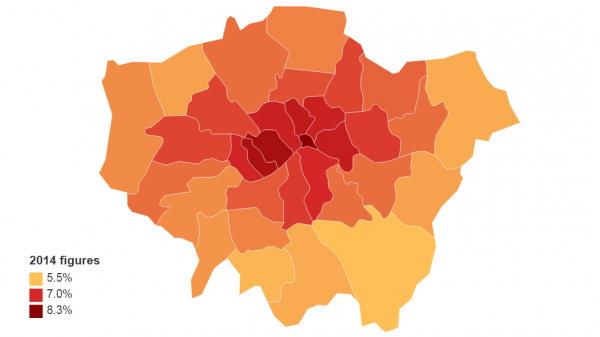T-charge will cost Londoners £23million a year for ‘negligible’ improvement in air quality

– TfL predicts just a 1-3% reduction in NOx (nitrous oxide) emissions
– 9,000 drivers every day set to be hit with £10 charge
– Small businesses with older vehicles will be hardest hit
The Mayor of London’s T-charge will cost Londoners £23million a year despite having only a ‘negligible’ impact on pollution, it has been revealed.
Transport for London’s own assessment concludes the £10 daily charge for vehicles that are over ten years old will save just 1-3% of NOx (nitrous oxide) emissions – a figure described as ‘negligible’ by TfL.
The assessment also concludes the anticipated reduction in air pollution will be ‘low’.
Small businesses with older vehicles will be hardest hit, facing charges of £2,600 a year* or having to fork out between £3,000 and £7,000 to renew their vehicles.
TfL estimates that 9,000 non-compliant vehicles will enter the T-charge zone every day, at a total cost of over £23million a year**.
London Assembly member Shaun Bailey said:
“If the Mayor wants to impose a £23million annual cost to Londoners that disproportionately affects small businesses, he needs a strong justification for doing so.
“Unfortunately TfL’s own assessments of his T-charge show it to be little more than a vanity project that will do next to nothing to improve London’s air pollution. The charge will inflict crippling additional costs on small businesses and sole traders that could be the difference between folding or surviving, as well as causing expense, disruption and bureaucracy for London residents.
“This entire proposal flies in the face of Sadiq Khan’s claims of being a ‘pro-business Mayor’ and imposes a pointless pollution tax that does nothing to tackle the issues it was created to combat.
“The Mayor has made many empty promises since his arrival at City Hall but none have hit the pockets of ordinary Londoners as hard as this. I’d like to see him reassess his plans and look at effective ways of improving our city’s environment.”
T-charge
· *Based on a £10 charge for each of the 260 working days
· **7,000 non-compliant cars and 2,000 non-compliant vans are expected to travel every day within the T-Charge area. As the daily charge is £10 a day, if all of these 9,000 vehicles have to pay the daily charge for every working day (260 days), this will be a total cost to Londoners of around £23 million in the first year.
· The T-Charge will only save between 1 and 3% of NOx (nitrous oxide) emissions. TfL’s own consultation document (B6: Assessment outcomes, attached) describes this as a ‘negligible’ impact on air quality and health.
· The T-Charge is virtually meaningless when it comes to HGVs and coaches, as they are already subject to the Londonwide Low Emission Zone, with a minimum standard of Euro IV (the same as the T-Charge).
· The minimum vehicle replacement cost (taking into account trade-in value and depreciation) is £2,400 for cars and £3,000 for vans. Using the figures above for non-compliant cars and vans, if all vehicles were replaced, this would also be a total cost of around £23 million. However, this is very much a minimum figure, as it will not be the same vehicles using the zone each day.
· The T-charge will mainly come to an end when the ULEZ begins, either in 2019 or 2020. However, it has an absurd feature where it will continue for a further three years for residents who live within the zone, in order to charge them £1 a day on top of the Congestion Charge. This is because those residents will have a three-year exemption from the ULEZ and will therefore continue to pay the T-Charge at the 90% resident discount rate. This situation could be further complicated if/when the ULEZ is made larger, if residents in those areas also gain a three-year exemption from the ULEZ.

 Posted by
Posted by 